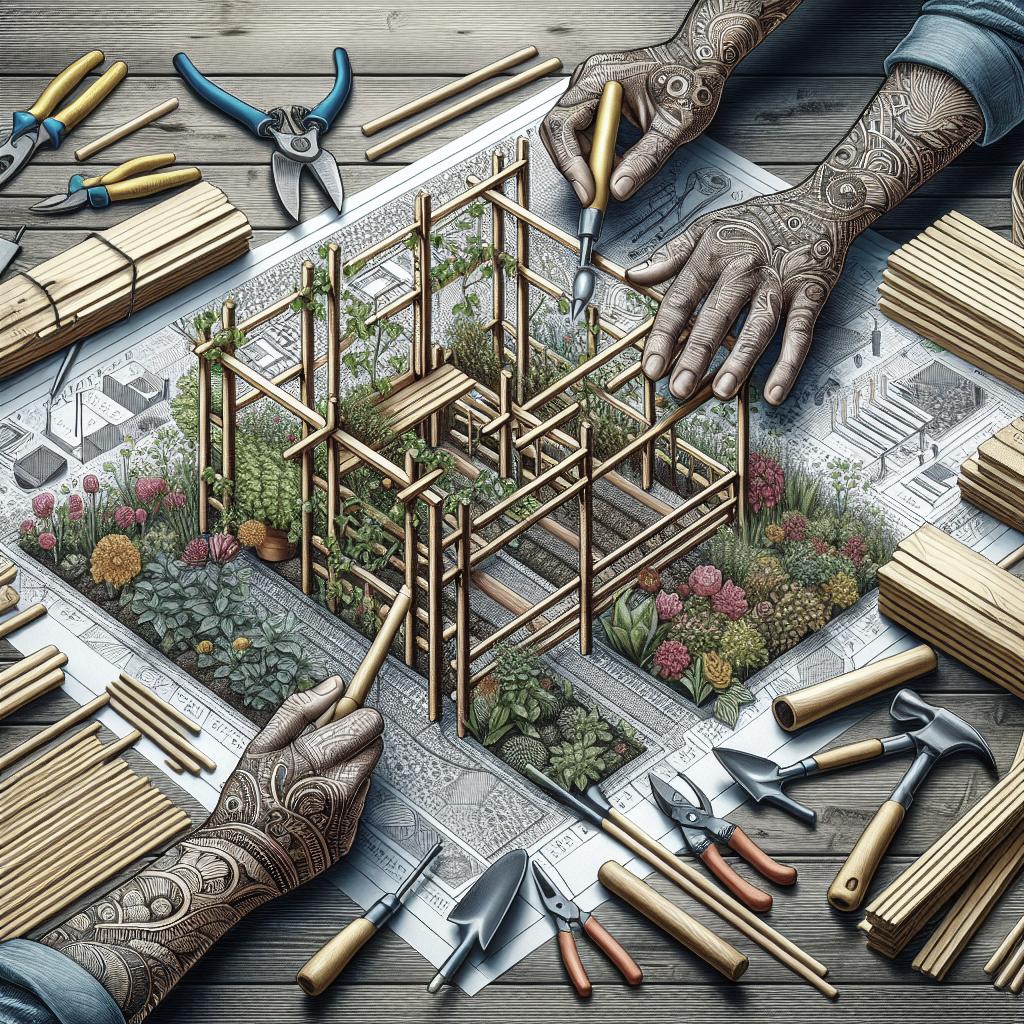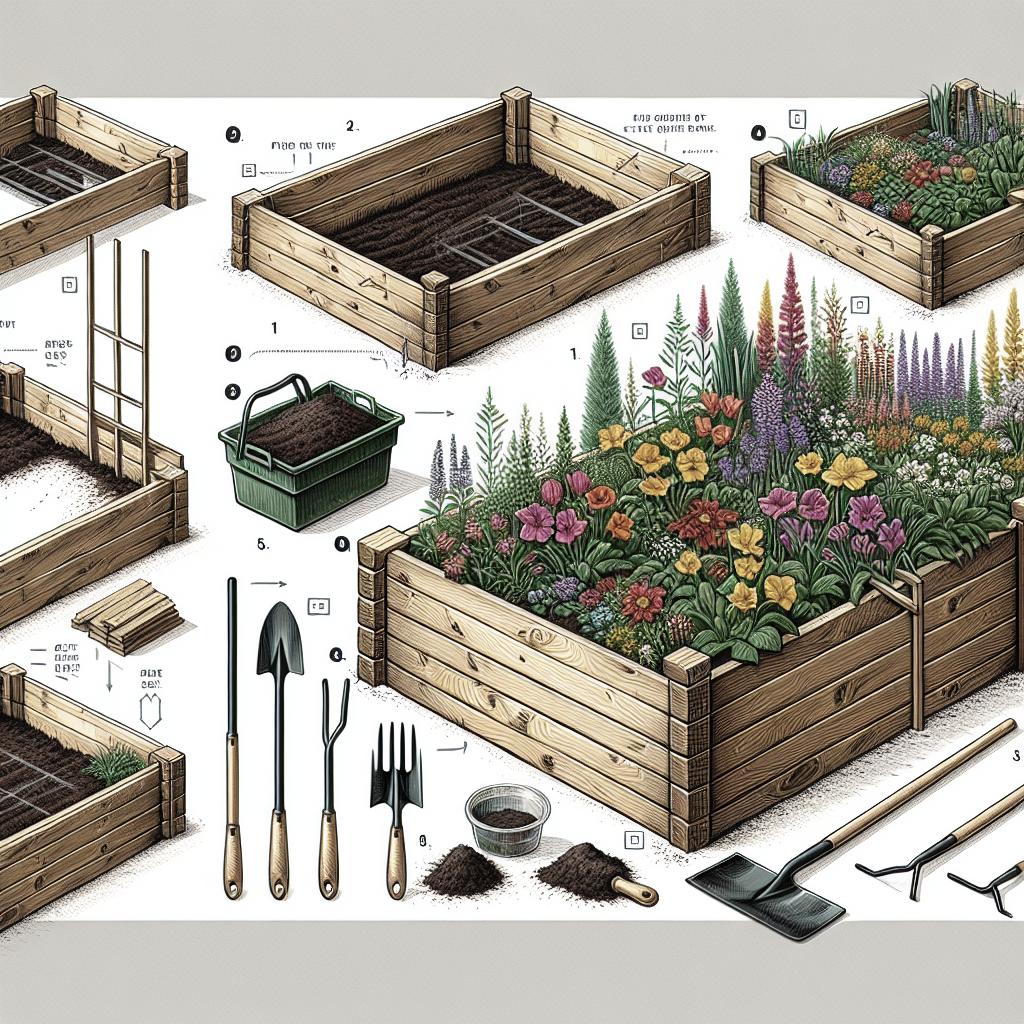“`html
How to Build a Garden Trellis
A garden trellis is a fantastic addition to any outdoor space, offering both aesthetic appeal and practical benefits by supporting climbing plants. In this guide, we will explore the various ways to use a trellis, what types of plants thrive on them, and how to choose the right materials, particularly focusing on wire types. We will provide step-by-step instructions for building a couple of different trellis designs, including considerations for choosing the best materials. Whether you choose a basic wire setup or a wood-framed masterpiece, you’ll find invaluable tips for every stage of the process. Finally, we’ll dive into unique design ideas for those looking to experiment with creativity in their garden.
Ways to Use a Trellis
The use of a trellis in your garden can transform your space in numerous ways. Firstly, they can save space by allowing vertical plant growth. This is especially useful in smaller gardens or urban environments where horizontal space is limited. Instead of sprawling on the ground, plants can climb up, making room for diversity in your garden plot.
Trellises can also serve as natural partitions. They can delineate garden sections or create secluded areas within your yard. By adding privacy or style, a trellis can become an integral component of landscaping. Finally, they add an element of design, as climbing plants and flowers can create living walls that bring beauty to otherwise mundane spaces.
What Kind of Plants Grow on a Trellis?
Choosing the right plants for your trellis can mean making a beautiful and functional garden feature. Some of the most popular plants suitable for trellises include climbing roses, clematis, and wisteria. These flowering plants add a burst of color, and with the support provided by a trellis, they can grow to their full potential.
In addition to flowering plants, many vegetables thrive on trellises. Tomatoes, cucumbers, peas, and beans can all benefit from the support a trellis offers. The vertical growth not only saves space but also facilitates easier harvesting. Ensure you select plants suitable for your climate and trellis design to ensure robust growth.
What Type of Wire to Use for a Trellis
When considering wire for a trellis, gauge and material are crucial. Common wire options include galvanized wire, plastic-coated wire, and remesh wire. Galvanized wire is rust-resistant and strong, making it a durable choice for outdoor use. Plastic-coated wire offers additional protection and visual appeal, often available in various colors to blend or contrast with your garden.
Remesh wire is an industrial option used commonly for its strength and rigidity. When selecting wire, consider your environmental conditions, the weight of plants, and aesthetics. The correct choice enhances both functionality and appearance, allowing your trellis to serve its purpose effectively for years.
Pros & Cons of Remesh Wire
Remesh wire is popular in trellis building due to its high strength and durability. Being initially designed for concrete reinforcement, it can readily withstand various weather conditions and heavy plant weights. The grid pattern facilitates climbing plants, ensuring ample surface for tendrils and vines to wrap around.
However, remesh wire comes with its cons too. Its thickness and rigidity can make it challenging to handle without proper tools. Depending on your desired aesthetic, its industrial look might not blend well with more delicate garden settings. Consider your garden’s specific needs before settling on remesh wire as your trellis material.
HOW TO BUILD A TRELLIS: OPTION ONE
Building a simple wire trellis is an excellent place for beginners to start. This guide will walk you through the steps needed to create a sturdy trellis using minimal materials and tools. You’ll gain confidence in working with wire and developing essential DIY skills that will serve you well in future garden projects.
Materials Needed
For a basic wire trellis, you’ll need the following materials:
- Galvanized or remesh wire sheet
- Wire cutters
- Gloves
- Support stakes (wooden or metal)
- Zip ties or garden wire for fastening
- Measuring tape
Instructions
Once you’ve gathered your materials, follow these simple instructions to build your wire trellis:
- Measure out the desired height and width for your trellis, ensuring your wire sheet is cut to the correct size.
- Secure the wire to the support stakes using zip ties or garden wire, ensuring firm attachment to withstand plant weight.
- Position your completed trellis in your desired garden location, ensuring it receives the necessary sunlight for plant growth.
Would you like to save this?
Embedding a simple wire trellis can transform your garden space. With minimal effort and materials, this project suits anyone looking to enhance their garden’s functionality and beauty. Keep your plants flourishing season after season by saving this project idea and revisiting it as your garden expands.
HOW TO BUILD A TRELLIS: OPTION TWO (WOOD FRAME)
For those desiring a more robust and aesthetically pleasing option, a wood-framed trellis offers the perfect solution. This design provides extra support for heavier plants and a more traditional garden look. It requires more effort and coordination but results in a long-lasting structure that enhances any garden’s charm.
Materials Needed
To build a wood-framed trellis, you’ll need:
- Wooden beams or planks
- Remesh wire panel
- Wood screws and screwdriver
- Hammer and nails
- Measuring tape and pencil
- Wood saw
- Drill
Instructions
Step 1) Take Measurements
Begin by measuring the area where you want to install the trellis. Take into account the size of your plants and the growth space required. Use the measurements to cut your wooden beams to the desired height and width using a wood saw.
Step 2) Build the Trellis Wood Frame
Construct your trellis frame on a flat surface by connecting your cut wooden beams. Use a drill and wood screws to secure the corners and form a rectangular shape. Double-check all connections are tight to ensure structural stability.
Step 3) Attach the Remesh Panel to Wood Frame
Carefully align the remesh panel with the wood frame. Use nails or wood screws to attach the panel securely to the frame. Ensure that the panel is centered and that no sharp metal edges protrude, as these could damage plants or become safety hazards.
Step 4) Install the Trellis
With your trellis constructed, move it to its desired location in the garden. Anchor securely by driving the base into the ground or attaching it to a sturdy wall or fence. Verify it’s upright and level so plants can grow evenly.
Double Remesh Wood-Frame Trellis
A double remesh wood-frame trellis is perfect for those needing extra support for heavier plants or desiring more intricate designs. This option involves layering two remesh panels for added strength, allowing a greater variety of plants to flourish.
Begin by constructing a standard wood frame as described above. Once in place, layer another remesh sheet over the existing one and secure it with additional screws. This added reinforcement ensures robust support and makes your trellis suitable for robust climbers.
Arched Trellises
Creating an arched trellis adds elegance to any garden setting, transforming it into a picturesque space. Such designs serve as entranceways or canopies over garden paths, adding both utility and style. Their architectural appeal offers significant visual interest.
Building an arched trellis requires more advanced skills and tools, often involving the bending of metal or PVC pipes to create the arch frame. Once the frame is constructed, you can attach wire or lattice panels to support plant growth, ensuring the structure remains sturdy and symmetrical.
Other Trellis Designs
Diversifying trellis designs can bring new life to your garden. Triangle, fan, and obelisk-shaped trellises are just a few options that cater to various plants and garden needs. These designs cater to different aesthetics, ranging from minimalist to ornate styles.
And that is how to build a trellis.
Experimenting with these designs brings a unique and personal touch to your garden. Customize sizes and materials to suit your garden’s environment and personal tastes. The possibilities are endless with trellis designs, offering functional and decorative solutions for every gardener.
| Subheading | Content Overview |
|---|---|
| Ways to Use a Trellis | Explores space saving, partitioning, and aesthetic-enhancing capabilities of trellises. |
| What Kind of Plants Grow on a Trellis? | Identifies flowering and vegetable plants suited for trellises, emphasizing climatic suitability. |
| What Type of Wire to Use for a Trellis | Offers considerations for wire selection, focusing on durability and aesthetics. |
| Pros & Cons of Remesh Wire | Analyzes remesh wire’s suitability, weighing its high strength against aesthetic limitations. |
| How to Build a Trellis: Option One | Introduces simple wire trellis construction with a list of needed materials. |
| How to Build a Trellis: Option Two (Wood Frame) | Details a method for constructing a wood-frame trellis, providing a material list and stepwise instructions. |
| Double Remesh Wood-Frame Trellis | Explains constructing a more robust trellis with layered remesh panels for additional support. |
| Arched Trellises | Highlights the elegance and functional design of arched trellises. |
| Other Trellis Designs | Explores various design styles beyond traditional trellis shapes to enhance garden creativity. |
“`


